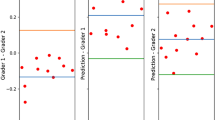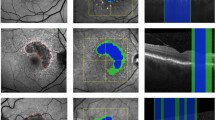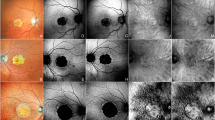Abstract
Purpose
To compare geographic atrophy (GA) size measured with fundus autofluorescence (FAF), near-infrared (N-IR) imaging, retromode (RM) imaging and optical coherence tomography angiography (OCTA) imaging and to compare accuracy of artificial intelligence(AI)-based automatic segmentation of GA with each method.
Methods
Available good quality FAF, N-IR- RM and OCTA images acquired on the same date for each patient diagnosed with GA from 2022 to 2024 were retrospectively collected. Seventy(70)% of the images were used to train a Trainable Weka Segmenter (v 3.3.2) based on manual segmentation of GA and spurious areas performed by 2 different blinded expert graders for each of the 4 imaging modalities. For the remaining 30%(testing set), automatic measurement and manual measurement were compared to determine accuracy of the segmentation.
Results
A total of 157 eyes were included. Mean ground truth GA area (graders’ manual contouring), mean automatic area and mean spurious area of testing set were significantly different with the 4 techniques(respectively p < 0.001, p < 0.001 and p = 0.002). Intraclass correlation coefficient(ICC) between manual and automatic measurements was 0.82 (0.78–0.84) for FAF model, 0.81 (0.78–0.82) for N-IR model, 0.67 (0.64–0.71) for RM model and 0.77 (0.73–0.81) for OCTA model.
Conclusion
We report very good performance of automatic segmentation performed on FAF, N-IR and OCTA. A slight overestimation of GA area with automatic measurements would be considered when assessing GA area on FAF and N-IR imaging. RM imaging should not be considered as a valid method for automatic GA area assessment due to superiority of other available enface imaging techniques.
This is a preview of subscription content, access via your institution
Access options
Subscribe to this journal
Receive 18 print issues and online access
$259.00 per year
only $14.39 per issue
Buy this article
- Purchase on SpringerLink
- Instant access to full article PDF
Prices may be subject to local taxes which are calculated during checkout



Similar content being viewed by others
References
Querques G, Amblard JC, Andrao A, Badura F, Bandello F, Holz F, et al. Expert Consensus on Geographic Atrophy in the EU: A Call for Urgent Policy Action. Ophthalmol Ther. 2024;13:867–81. https://doi.org/10.1007/s40123-024-00899-x
Guymer RH. Treating Geographic Atrophy–Are We Ready? A Call to Image. Oph Retin. 2023;7:1–3. https://doi.org/10.1016/j.oret.2022.08.022
Ahluwalia A, Shen LL, Bao Y, Sun M, Young BK, Park MM, et al. The influence of the topographic location of geographic atrophy on vision-related quality of life in nonexudative age-related macular degeneration. Graefes Arch Clin Exp Ophthalmol. 2023;261:699–708. https://doi.org/10.1007/s00417-022-05849-6
Shen LL, Sun M, Ahluwalia A, Young BK, Park MM, Toth CA, et al. Relationship of Topographic Distribution of Geographic Atrophy to Visual Acuity in Nonexudative Age-Related Macular Degeneration. Ophthalmology Retin. 2021;5:761–74. https://doi.org/10.1016/j.oret.2020.11.003
Künzel SH, Möller PT, Lindner M, Goerdt L, Nadal J, Schmid M, et al. Determinants of Quality of Life in Geographic Atrophy Secondary to Age-Related Macular Degeneration. Investigative Ophthalmol Vis Sci. 2020;61:63. https://doi.org/10.1167/iovs.61.5.63
Fleckenstein M, Mitchell P, Freund KB, Sadda S, Holz FG, Brittain C, et al. The Progression of Geographic Atrophy Secondary to Age-Related Macular Degeneration. Ophthalmology. 2018;125:369–90. https://doi.org/10.1016/j.ophtha.2017.08.038
Lindner M, Böker A, Mauschitz MM, Göbel AP, Fimmers R, Brinkmann CK, et al. Directional Kinetics of Geographic Atrophy Progression in Age-Related Macular Degeneration with Foveal Sparing. Ophthalmology. 2015;122:1356–65. https://doi.org/10.1016/j.ophtha.2015.03.027
Thiele S, Nadal J, Pfau M, Saßmannshausen M, Fleckenstein M, Holz FG, et al. Prognostic value of intermediate age-related macular degeneration phenotypes for geographic atrophy progression. British J Ophthalmol. 2021;105:239–45. https://doi.org/10.1136/bjophthalmol-2020-316004
Wu Z, Fletcher EL, Kumar H, Greferath U, Guymer RH. Reticular pseudodrusen: A critical phenotype in age-related macular degeneration. Progress Retinal Eye Res. 2022;88:101017. https://doi.org/10.1016/j.preteyeres.2021.101017
Fleckenstein M, Schmitz-Valckenberg S, Adrion C, Visvalingam S, Göbel AP, Mössner A, et al. Progression of age-related geographic atrophy: role of the fellow eye. Invest Ophthalmol Vis Sci. 2011;52:6552–7. https://doi.org/10.1167/iovs.11-7298
Domalpally A, Danis RP, White J, Narkar A, Clemons T, Ferris F, et al. Circularity Index as a Risk Factor for Progression of Geographic Atrophy. Ophthalmology. 2013;120:2666–71. https://doi.org/10.1016/j.ophtha.2013.07.047
Vogl WD, Riedl S, Mai J, Reiter GS, Lachinov D, Bogunović H, et al. Predicting Topographic Disease Progression and Treatment Response of Pegcetacoplan in Geographic Atrophy Quantified by Deep Learning. Ophthalmology Retin. 2023;7:4–13. https://doi.org/10.1016/j.oret.2022.08.003
Nattagh K, Zhou H, Rinella N, Zhang Q, Dai Y, Foote KG, et al. OCT Angiography to Predict Geographic Atrophy Progression using Choriocapillaris Flow Void as a Biomarker. Translational Vis Sci Technol. 2020;9:6. https://doi.org/10.1167/tvst.9.7.6
You QS, Camino A, Wang J, Guo Y, Flaxel CJ, Hwang TS, et al. Geographic Atrophy Progression Is Associated With Choriocapillaris Flow Deficits Measured With Optical Coherence Tomographic Angiography. Investigative Ophthalmol Vis Sci. 2021;62:28. https://doi.org/10.1167/iovs.62.15.28
Holz FG, Bindewald-Wittich A, Fleckenstein M, Dreyhaupt J, Scholl HPN, Schmitz-Valckenberg S. Progression of Geographic Atrophy and Impact of Fundus Autofluorescence Patterns in Age-related Macular Degeneration. American J Ophthalmol. 2007;143:463–72.e2. https://doi.org/10.1016/j.ajo.2006.11.041
Arslan J, Samarasinghe G, Benke KK, Sowmya A, Wu Z, Guymer RH, et al. Artificial Intelligence Algorithms for Analysis of Geographic Atrophy: A Review and Evaluation. Translational Vis Sci Technol. 2020;9:57. https://doi.org/10.1167/tvst.9.2.57
Streho M, Lavallee G, Aimadaly M, Perrenoud F, Puech M, Tadayoni R, et al. Geographic Atrophy and OCT Angiography: Descriptive Study and Correlation With Autofluorescence. Ophthalmic Surg, Lasers Imaging Retin. 2019;50:e222–e228. https://doi.org/10.3928/23258160-20190905-13
Corradetti G, Byon I, Corvi F, Cozzi M, Staurenghi G, Sadda SR. Retro mode illumination for detecting and quantifying the area of geographic atrophy in non-neovascular age-related macular degeneration. Eye. 2022;36:1560–6. https://doi.org/10.1038/s41433-021-01670-3
Corbelli E, Sacconi R, Rabiolo A, Mercuri S, Carnevali A, Querques L, et al. Optical Coherence Tomography Angiography in the Evaluation of Geographic Atrophy Area Extension. Investigative Ophthalmol Vis Sci. 2017;58:5201–8. https://doi.org/10.1167/iovs.17-22508
Borrelli E, Olivieri C, Serafino S, Coletto A, Ricardi F, Neri G, et al. Interreader and Intermodality Variability in Macular Atrophy Quantification in Neovascular Age-related Macular Degeneration: Comparison of 6 Imaging Modalities. Ophthalmology Retina. Published online August 30, 2024. https://doi.org/10.1016/j.oret.2024.08.017
Abdelfattah NS, Sadda J, Wang Z, Hu Z, Sadda S. Near-Infrared Reflectance Imaging for Quantification of Atrophy Associated with Age-Related Macular Degeneration. American J Ophthalmol. 2020;212:169–74. https://doi.org/10.1016/j.ajo.2020.01.005
Arslan J, Samarasinghe G, Sowmya A, Benke KK, Hodgson LAB, Guymer RH, et al. Deep Learning Applied to Automated Segmentation of Geographic Atrophy in Fundus Autofluorescence Images. Translational Vis Sci Technol. 2021;10:2. https://doi.org/10.1167/tvst.10.8.2
Sarao V, Veritti D, Nardin AD, Misciagna M, Foresti G, Lanzetta P. Explainable artificial intelligence model for the detection of geographic atrophy using colour retinal photographs. BMJ Open Ophthalmol. 2023;8:e001411. https://doi.org/10.1136/bmjophth-2023-001411
Crincoli E, De Rosa I, Miere A, Colantuono D, Mehanna CJ, Souied EH. Comparison of Multimodal Imaging for the Characterization of Geographic Atrophy. Transl Vis Sci Technol. 2022;11:21. https://doi.org/10.1167/tvst.11.11.21
Schmidt-Erfurth U, Mai J, Reiter GS, Riedl S, Vogl WD, Sadeghipour A, et al. Disease Activity and Therapeutic Response to Pegcetacoplan for Geographic Atrophy Identified by Deep Learning-Based Analysis of OCT. Ophthalmology. 2025;132:181–93. https://doi.org/10.1016/j.ophtha.2024.08.017
Acknowledgements
Italian Ministry of Health -RC2025.
Author information
Authors and Affiliations
Contributions
Design of the study: MCS, EC; Analysis: MCS, EC, AG; Interpretation: AS, CR, MMC, RK; Draft: EC; Revision: MCS, AS, SR.
Corresponding author
Ethics declarations
Competing interests
The authors declare no competing interests.
Ethical approval
The study adhered to the declaration of Helsinki and the protocol was approved by the Ethics Committee of Università Cattolica del Sacro Cuore di Roma (n959).
Additional information
Publisher’s note Springer Nature remains neutral with regard to jurisdictional claims in published maps and institutional affiliations.
Supplementary information
Rights and permissions
Springer Nature or its licensor (e.g. a society or other partner) holds exclusive rights to this article under a publishing agreement with the author(s) or other rightsholder(s); author self-archiving of the accepted manuscript version of this article is solely governed by the terms of such publishing agreement and applicable law.
About this article
Cite this article
Savastano, M.C., Crincoli, E., Savastano, A. et al. Comparison of effectiveness of geographic atrophy automatic segmentation with different imaging methods. Eye 39, 2003–2007 (2025). https://doi.org/10.1038/s41433-025-03794-2
Received:
Revised:
Accepted:
Published:
Issue date:
DOI: https://doi.org/10.1038/s41433-025-03794-2



